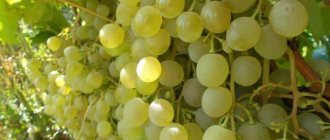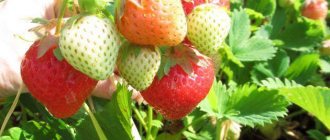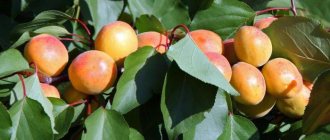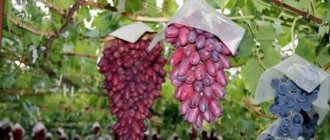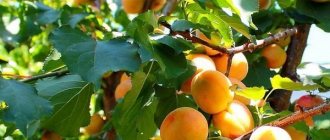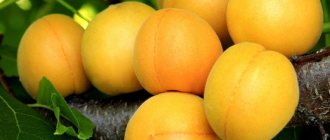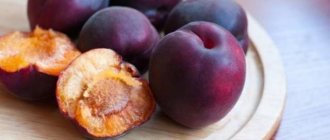History of selection
The ancestor of the Champion of the North is considered to be the well-known and widespread apricot Triumph northern. It was on its basis that a new promising variety was developed by crossing open pollination with other varieties of apricot and subsequent sowing. Selection work to develop the Champion of the North was carried out on the basis of Voronezh State Agrarian University (Voronezh State Agrarian University) under the guidance of two botanists: L. A. Dolmatova and A. N. Venyaminov in the 70s of the last century.
The goal of the breeders was to obtain an apricot that would survive and successfully bear fruit in the extreme conditions of severe winter frosts, punctuated by sudden, sharp thaws. Such a changeable climate in winter, as well as probable late spring frosts, are typical for the Central Black Earth zone, for which the apricot variety was intended. Over time, the Champion of the North began to be cultivated far beyond these borders: in the Belgorod, Voronezh, Tambov, Kursk, Lipetsk and even in the Moscow (Moscow region) regions.
Important! Apricot Champion of the North does not have official accreditation in the Russian State Register.
Northern Triumph was used in the development of many frost-resistant apricot varieties
Description of the variety
Compared to other apricot trees, which often reach 8 m in height, the Champion of the North is considered a low-growing variety, since it rarely outgrows 4-5 m. Due to the slowly forming shoots, its spherical crown is not too dense, sparse, but the skeletal branches are powerful and thick, covered with brownish-brown bark, smooth to the touch. The leaf blades of the Champion of the North apricot are of a regular shape, medium in size, shiny and smooth, colored in a standard light green shade, changing to a spectacular orange-red in the fall.
Delicate flowers are pink-lilac or almost white with juicy pink stamens, quite large (up to 30 mm). Champion of the North is a self-fertile variety, since both male and female flowers are present on the tree at the same time. The spiny shoots on apricot shoots that bear buds (floral and vegetative) end in beautiful inflorescences.
The ripened fruits of the Champion of the North, judging by the numerous photos of gardeners growing this apricot, are roundish-oval in shape, covered with a thick velvety-pubescent skin of a rich sunny orange color with a light crumbly raspberry blush. The inner pulp of the apricot is slightly sour, refreshingly sweet, dense and dry, easily separated from the rather large free pit. The apricot kernel is edible, sweet, with a pronounced almond flavor.
Important! In terms of taste, Champion of the North is assessed by expert tasters as good and excellent (on average 4.6 points).
The fruits of this apricot variety are very attractive in appearance.
Features of cultivation
Although the Champion of the North was created for growth in conditions that are far from southern, still, even when growing it in the Moscow region or more northern places, it is necessary to select a site in your garden for the young seedling so that the crop receives as much light and solar heat as possible. It should not be a lowland or a place with high groundwater; A drafty area is also not suitable. It is best to place the apricot tree in the southwest of the garden next to the wall of the house or near the fence. It is advisable that no other large trees or shrubs grow nearby, as apricot loves freedom. Champion is unpretentious in soil composition. The main thing is that it is fertilized when planting. The optimal acidity level is neutral or slightly alkaline (pH 7.0–8.5). When planting cuttings, it is important to moisten the soil, make it loose and well-drained.
When choosing a seedling, it is recommended to give preference to two-year-old specimens growing with a closed root system (the root is in a container). A healthy seedling has smooth, even bark and several branches. A slight curvature can be observed in the lower part of the trunk - the result of grafting.
Young plants can be planted in autumn or spring - it all depends on the growing region. If there are doubts that the cuttings will have time to take root before the onset of cold weather, then it is better to plant in the spring - then the bushes are guaranteed to have time to adapt to the new living conditions.
The cuttings are planted in large planting holes (50*50 centimeters) with an enrichment composition (peat, humus or compost, complex mineral fertilizer) added to them in advance. The seedling is placed on a small mound, carefully straightening the roots along it and directing them downwards. The root collar should be 5-7 centimeters above the ground. From above, the soil around the trunk is slightly compacted and the trunk circle is sealed for irrigation. For each young seedling, use up to 3 buckets of water, avoiding moisture getting on the neck. It is important to mulch the soil after the first watering - this will eliminate the need for frequent watering until the plant is fully established. In windy weather conditions, the seedling can be tied to a support. The distance between seedlings should be at least three meters.
Characteristics
From his ancestor, Champion of the North received exceptional varietal characteristics. They allow the apricot to survive in places with a completely unsuitable climate.
Drought resistance, winter hardiness
The most important quality that distinguishes Champion of the North from other apricot varieties is its amazing winter hardiness. The wood of the trunk and branches can withstand frosts down to -35 °C and even lower. Flower buds show slightly worse frost resistance and in particularly harsh winters they often freeze slightly (during sudden temperature changes). But the Champion of the North variety is endowed with a natural ability to regenerate, so it recovers on its own, while freezing has virtually no effect on apricot yield.
The Champion of the North survives multi-day heat (above +25 °C) easily - thanks to its strong and thick bark. The lack of natural precipitation does not in any way affect the formation of ovaries and the ripening of apricots if the trees are watered regularly and abundantly, and the soil in the tree trunk is mulched.
Pollination, flowering period and ripening time
The apricot flowering period is short - no more than 10 days, usually occurring in the last week of April or the first half of May. The Champion of the North is self-pollinating, but in order to increase productivity, experienced gardeners recommend planting pollinator plants of other related apricot varieties (Lel, Northern Triumph) in close proximity to it. In terms of ripening time, Champion of the North is classified as a mid-late variety.
Apricot tree branches covered with flowers
Productivity, fruiting
The young seedling of the Champion of the North blooms for the first time already in the third season after planting; in the same year, minor fruiting can be expected. Apricot trees reach their peak yield (25-30 kg) at 5-6 years of age; they can live up to 30-35 years. The maximum weight of one ripe fruit is 65 g, but on average the weight usually varies between 50-55 g. If too many ovaries have formed on the Champion of the North tree, then the apricots become noticeably smaller, barely reaching 30-35 g. Fruiting is consistent, lasting about 3 -3.5 weeks. Apricot fruits begin to ripen en masse from mid-July.
Area of application of fruits
The Champion of the North has a universal scope. Most often, the fruits are eaten immediately fresh or dried. Apricots are suitable as an ingredient for all kinds of fruit desserts (salads, confiture, jam, preserves). They can be frozen, canned (compotes), and also used to prepare sweet dessert alcoholic drinks (cordials, wine, liqueurs).
Resistance to diseases and pests
Apricot Champion of the North is quite resistant to various infectious and fungal pathologies and demonstrates good immunity to them. However, gardeners warn about the extremely low resistance of the variety to hole spot and gray rot. All kinds of insects very often settle on apricot trees, causing them significant harm.
Advantages and disadvantages
The undoubted positive qualities inherent in the Champion of the North include:
- drought resistance;
- excellent and stable yield;
- self-pollinating;
- large fruit;
- high marketability of ripe apricots (appearance);
- early fruiting (the first harvest of apricots will be in the 3-4th season);
- excellent traditional apricot taste;
- transportability;
- highest frost resistance;
- resistance to a number of diseases (thanks to the loose and unthickened crown);
- versatility of use;
- good keeping quality of apricots.
Even proper storage is impossible for a long time
Along with a lot of advantages, the Champion of the North variety also has some negative aspects:
- the possibility of freezing (with sharp amplitude changes in temperature) of fruit buds;
- some dryness and fibrousness of ripe apricot fruits, as well as characteristic sourness (especially the skin);
- the need for pollinators (in case of unfavorable weather, self-pollination will be poor);
- susceptibility to moniliosis;
- exposure to massive attacks by a large number of pests.
Characteristics of apricot
Also check out these articles
- Hyacinth flower
- Zucchini in tomato
- How long does pregnancy last in rabbits and how many days do rabbits give birth?
- How to properly vaccinate a peach in spring
With proper care, the Champion of the North tree can live for about 30 years. What other qualities does this variety have:
- Self-fertile - does not require pollinators. And yet, if you plant Triumph Northern or a similar apricot variety nearby, the crop’s yield will increase.
- Immunity is average. The crop rarely suffers from clusterosporiosis, but it can be affected by other diseases, especially fungal ones.
- Fruits of commercial quality, beautiful, aromatic, attract attention on the counter.
- Average yield is 20-35 kg/tree.
- The harvested crop can be transported over long distances.
- The taste is excellent, 4.5 points out of 5 possible.
- The frost resistance of the tree is high, up to -30 degrees or even higher with proper care, but the flower buds can freeze slightly.
Frost resistance down to -30 degrees, but flower buds may freeze slightly
Landing Features
The Champion of the North is not particularly capricious. However, when planting this apricot, it is necessary to adhere to clear rules of agricultural technology.
Recommended timing
The best time to plant the Champion of the North is considered to be early spring, when nature is just waking up from sleep, and active sap flow has not yet begun. The exact timing directly depends on the local climate. It is permissible to plant apricot trees in the autumn before the onset of persistent frosts.
Choosing a suitable location
When choosing the optimal place for planting apricots, you must remember that, like all stone fruits, this crop is very light-loving. The Champion of the North will develop better and bear fruit more abundantly in well-lit, open and sun-warmed spaces. The presence of groundwater close to the surface (above 1.2 m) should not be allowed. Lowlands and flooded areas are not suitable for apricot. The place must be protected from sharp gusty winds and drafts.
Attention! It is ideal to place the Champion of the North apricot tree on the leeward, southern side of the building, or on a slope directed to the south (southeast, southwest).
What crops can and cannot be planted next to apricots?
Champion of the North, like other apricot varieties, needs to be planted separately. It cannot stand close proximity to fruit crops. The large plant competes with shrubs and other trees for moisture and nutrients. Some stone fruits (peaches, cherries) have common pests and are susceptible to the same diseases.
An apricot tree can get along well in close proximity only to its direct relatives, who are also pollinators. It is permissible to grow garden and ornamental crops (greens, flowers, lawn grass) in the tree trunk of an aged apricot.
Important! Nightshades (eggplants, potatoes, tomatoes) and garden strawberries should not be placed next to the Champion of the North, as they often spread a dangerous incurable disease - verticillium wilt.
Apricot trees are considered solitary plants
Selection and preparation of planting material
1-2 year old seedlings of the Champion of the North take root best. Older specimens tolerate transplantation much more difficult. High-quality apricot planting material is characterized by:
- a healthy and branched root system, without signs of rot or any damage;
- the presence of healthy, large and strong kidneys;
- straight, uncurved trunk;
- several intact and strong branches.
It is better to purchase apricot seedlings in the autumn, when the choice is wider and the quality of planting material is much higher. In order for the apricot tree to be safely preserved until spring, its roots are dipped in a clay mash diluted to the consistency of liquid sour cream. After the clay dries a little, the plant is placed in a box with wet sand or sawdust, kept at a temperature of up to +3+5 °C (underground, basement). You can also save the Champion of the North apricot in the open ground on your site by digging a hole and placing a seedling in it at an angle. The roots must be covered with soil.
Landing algorithm
The technology for planting the Champion of the North is as follows:
- In about 3-4 weeks (possible even in autumn), a planting hole for apricot is prepared - about 0.6 m in depth and in diameter.
- From dug up fertile soil, humus, low-lying peat and coarse sand, taken in equal parts, adding superphosphate (200-250 g), nitroammophoska (150-170 g) and wood ash (0.8-1 kg), mix the soil mixture.
- A mound is formed from the prepared nutrient soil at the bottom of the pit.
- Drive the support stake approximately 10-15 cm from the center.
- Having carefully spread the apricot roots in different directions, a Champion of the North seedling is placed on the hill and tied to a support. The plant needs to be shortened to 0.6-0.8 m and all branches trimmed.
- The planting hole is filled to the top with soil mixture, compacted, trampled down and a roller is formed for watering in the tree trunk circle. Lay mulch (needles, peat, humus).
- Apricot seedlings are watered generously.
Apricot seedlings are planted in the same way as other stone fruits.
Features of care
Maintenance measures include regular watering, fertilizing, formative pruning of the crown, and combating fungal diseases of trees.
Watering
One of the important stages of caring for apricot trees is watering them. Possessing high drought resistance, apricot at certain periods of its development needs an enhanced watering regime. These include:
- growing season spring. At this time, shoots grow intensively, the root system develops, and flower buds are formed;
- summer period. At the end of May - June, the fruits are set and filled. It is advisable to completely stop watering apricots 2–4 weeks before harvesting;
- autumn period. In autumn, pre-winter (moisture-recharging) watering of trees is carried out, which promotes better ripening of shoots, the formation of new flower buds, and activates root growth, which significantly increases the winter hardiness of plants.
The amount of water used for irrigation depends on the age of the trees and the time of year. In spring and summer, at least 30–40 liters of water must be used for one mature tree. During autumn watering, this amount increases by 1.5 times and is about 50–60 liters. To water young seedlings, 2-3 buckets of water per tree are enough. In total, during the growing season there should be at least 3-4 waterings, and in hot, dry weather this amount increases to 5-8 times.
Trees should be watered early in the morning or in the evening, 2–3 hours before sunset. To avoid waterlogging of the apricot root collar, watering should be done in the furrow of the trunk circle (a groove 15–20 cm deep). The soil under the tree should be saturated with water to a depth of at least 50–70 cm.
After watering, the surface of the tree trunk circle is mulched with humus, peat, and dry grass.
When watering apricots, water is poured into specially prepared annular grooves
Top dressing
Feeding trees with organic and mineral fertilizers allows them to maintain vital activity at a high level, form strong shoots and roots, produce good quality fruits and safely endure winter frosts and summer heat.
The main components of fertilizers for feeding apricots are nitrogen, phosphorus and potassium:
- nitrogen allows the tree to increase vegetative mass and favors the formation of flower buds and fruit set;
- phosphorus accelerates biological processes in the plant’s body, due to which trees enter the fruiting period earlier and productivity increases;
- The presence of potassium in fertilizers enhances the winter hardiness and drought resistance of apricots and extends the process of fruit ripening over time.
1-year-old trees planted according to the rules of agricultural technology (all necessary fertilizers are added to the planting hole) are not fed for 1–2 years after planting. In the spring and summer, fertilizing is carried out in liquid form (watering and spraying). In autumn - mainly in solid form (for digging). Fertilizers should be applied into the furrow of the tree trunk circle. Before fertilizing, you need to water the tree well. Foliar feeding of apricots by spraying is carried out early in the morning or in the evening, after sunset.
Table: root and foliar feeding of apricot
| Fertilizing period | Root feeding (for 1 tree) | Foliar feeding (per 1 tree) | Note | |
| Organic fertilizers | Mineral fertilizers | |||
| Seedlings 2–3 years old | ||||
| Early spring (March) | chicken manure + peat (compost) – 300 g per 10 liters of water | – | 700 g of urea per 10 liters of water | Before fertilizing, water with 2 buckets of water. |
| Before flowering (early May) | wood ash - 1 liter sprinkled on moist soil | 30 g of urea or ammonium nitrate per 10 liters of water | – | Before fertilizing, water with 2–3 buckets of water. |
| After flowering (early June) | wood ash - 2 liters per 10 liters of water | 30 g double superphosphate +20 g potassium sulfate +20 g copper sulfate per 10 liters of water | – | Before fertilizing, water with 3-4 buckets of water. |
| After the ovary falls (early July) | wood ash - 2 liters per 10 liters of water | 30 g double superphosphate +20 g potassium sulfate +20 g copper sulfate per 10 liters of water | complex fertilizer with microelements (Epin, Zircon, HB101) - according to the instructions | – |
| Fruit ripening (July - mid-August) | rotted manure - 1 bucket or wood ash - 0.5 l, dig up with soil | – | – | – |
| Autumn (October - November) | rotted manure or compost - dig up 15 kg with soil | – | – | Water-recharging irrigation – 3 buckets of water |
| Trees 3–4 years old | ||||
| Early spring (March) | chicken manure + peat (compost) – 300–500 g per 10 liters of water | – | 700 g of urea per 10 liters of water | Before fertilizing, water with 3 buckets of water. |
| Before flowering (early May) | wood ash - 1 liter sprinkled on moist soil | 30 g of urea or ammonium nitrate per 10 liters of water | – | Before fertilizing, water with 3-4 buckets of water. |
| After flowering (early June) | wood ash - 2 liters per 10 liters of water | 30 g double superphosphate +20 g potassium sulfate +20 g copper sulfate per 10 liters of water | – | Before fertilizing, water with 5–10 buckets of water. |
| After the ovary falls (early July) | wood ash - 2 liters per 10 liters of water | 30 g double superphosphate +20 g potassium sulfate +20 g copper sulfate per 10 liters of water | complex fertilizer with microelements (Epin, Zircon, HB101) - according to the instructions | – |
| Fruit ripening (July - mid-August) | rotted manure - 1 bucket or wood ash - 1.5 liters, dig up with soil | – | – | – |
| Autumn (October - November) | rotted manure or compost - dig up 30 kg with soil | – | – | Water-recharging irrigation – 5 buckets of water |
| Trees 6–8 years old | ||||
| Early spring (March) | chicken manure + peat (compost) – 800 g per 10 liters of water | – | 700 g of urea per 10 liters of water | Before fertilizing, water with 3 buckets of water. |
| Before flowering (early May) | wood ash - 1 liter sprinkled on moist soil | 30 g of urea or ammonium nitrate per 10 liters of water | – | Before fertilizing, water with 3-4 buckets of water. |
| After flowering (early June) | wood ash - 2 liters per 10 liters of water | 30 g double superphosphate +20 g potassium sulfate +20 g copper sulfate per 10 liters of water - 5–6 buckets | – | Before fertilizing, water with 5–10 buckets of water. |
| After the ovary falls (early July) | wood ash - 2 liters per 10 liters of water - 2 buckets | 30 g double superphosphate +20 g potassium sulfate +20 g copper sulfate per 10 liters of water - 3 buckets | complex fertilizer with microelements (Epin, Zircon, HB101) - according to the instructions | – |
| Fruit ripening (July - mid-August) | rotted manure - 1 bucket or wood ash - 1.5 liters, dig up with soil | Dig 300 g of potassium chloride + 300 g of superphosphate with the soil | – | – |
| Autumn (October - November) | rotted manure or compost - dig up 40–50 kg with soil | – | – | Water-recharging irrigation – 5 buckets of water |
Trees older than 9 years need up to 80 kg of humus or compost, about 0.4 kg of ammonium nitrate, 0.9 kg of superphosphate and 0.3 kg of potassium sulfate or chloride. This amount of fertilizer is evenly distributed over the periods of fertilizing depending on the condition of the tree.
Video: feeding apricots when grown in the middle zone
Crown trimming
When growing apricots, several main types of pruning are practiced:
- Formative pruning is the first for young seedlings and is aimed at forming the crown and overgrowing shoots during their strong growth. Seedlings are pruned before they begin to bear fruit. The optimal height for an apricot trunk (the distance from the ground to the base of the skeletal branches) is considered to be 0.5–0.6 m. The crown of a young seedling should be formed according to a sparsely tiered system, leaving 5–6 branches as the main (skeletal) branches. On these branches, branches of the next tier will subsequently grow - overgrowing, bearing in turn fruit-bearing shoots. In this case, the distance between the branches along the height of the trunk should not be less than 20–25 cm.
- Regulatory pruning of apricot is used from 2–3 years of age to slow down the growth of shoots and accelerate the period of entry into the fruiting period.
- Rejuvenating pruning helps stimulate the growth of new shoots. Necessary for aging trees when branch growth weakens or stops completely.
- Restorative pruning is used when trees are damaged by severe frosts, diseases or other unfavorable conditions. It helps plants regain their ability to grow and bear fruit sustainably.
The apricot crown is formed according to a sparse tiered system during the first 2–3 years after planting
As a rule, in the process of caring for apricot trees, several prunings are combined at the same time. Spring pruning involves removing damaged and excess branches that have frozen over the winter, thickening the crown and interfering with ventilation and uniform illumination of fruit-bearing shoots. The number of branches to be pruned includes perennial branches - vertical ones, growing inside the crown, and horizontal ones with a length of more than 1–1.5 m. Vertical branches are cut “into a ring”, to the base, without leaving stumps. Long horizontal shoots are shortened by 0.5–0.6 m per lateral (outward growing) bud. After such pruning, new fruit links are formed on the horizontal shoot. Fruit buds are laid on small short shoots (spears and spurs) and annual branches - fruit twigs, so they are not pruned. In the spring, all growth on the tree trunk, growing below the branching of the skeletal branches, is also removed.
Pruning is done before buds open (in late winter or early spring) only at positive air temperatures (6–8°C).
Summer pruning of apricot is also called green pruning, since it is done mainly on 1-year-old shoots. Pruning perennial branches in summer can cause gum formation (resin secretion) and weaken the tree, exposing it to disease. Therefore, in the summer, overgrown branches more than 30 cm long, growing inside the crown, the so-called “fatifying” branches, which do not have fruit links, are cut out. The exception is young shoots, which have many small shoots - spurs. Pruning is done in the first half of June, in good dry weather. Thanks to summer pruning, new shoots are formed, called shoots of the second wave of growth.
In the fall, after harvesting, if necessary, rejuvenating pruning of 6–8-year-old trees can be done. This pruning will help prepare the apricots for a safe winter. Remove dried branches and those affected by diseases and pests.
For any type of pruning, the cutting area of the shoots should be treated with garden varnish or natural-based oil paint.
Video: pruning apricot
Preparing for winter
In the fall, after the leaves fall, the trunk and the base of the skeletal branches must be whitewashed. This will protect the tree from sunburn in winter, and will help avoid gum bleeding in early spring, when, due to the difference in night and day air temperatures, the apricot bark cracks and wounds form on the trunk with the release of gum. For whitewashing, use slaked lime (2–3 kg per 10 liters of water) with the addition of 400 g of copper sulfate and a small amount of clay. Processing is carried out at positive air temperatures.
Control of apricot diseases and pests
A significant disadvantage of the Champion of the North variety is the low resistance of trees to fungal diseases. The greatest danger to apricots is moniliosis (monilial burn and monilial rot) and clasterosporia.
With a monilial burn, the flower stalks darken, quickly wither and fall off. The same thing happens with shoots and leaves. The bark of the trunk and branches cracks, and gum comes out of the cracks. The tree is affected by monilial burn in the spring.
Apricots get sick with monilial rot in the summer, during the ripening of the crop. Rot is characterized by the appearance of individual light gray and brown spots on the fruit. Mycelium remains on them in the form of gray and brown layers. After a week, affected apricots shrivel, dry out and fall off.
Apricots affected by moniliosis are covered with brown spots, which eventually affect the entire fruit
To treat trees affected by moniliosis, they are treated with fungicidal preparations Botran, Nitrafen, Polychom (spraying the crown and soil under the trees). Parts of the apricot affected by the disease must be removed and burned.
Table: prevention and treatment of fungal diseases of apricot
| Processing period | Moniliosis | Clusterosporiasis | |||||
| Prevention | Prevention | Treatment | |||||
| Spraying the tree crown | Spraying the crown and soil under the tree | Spraying the tree crown | |||||
| Early spring (March) | – | – | – | – | Copper sulfate 1% solution | Nitrafen - according to instructions | – |
| Budding | – | – | Carbamide (urea) 30 g per 10 liters of water | Chorus - according to instructions | – | – | 1% solution of Bordeaux mixture (100 g per 10 l of water) |
| Budding | 3% solution of Bordeaux mixture (300 g per 10 l of water) | – | – | – | – | – | 1% solution of Bordeaux mixture (100 g per 10 l of water) |
| Immediately after flowering | 3% solution of Bordeaux mixture (300 g per 10 l of water) | 4% solution of iron sulfate (400 g per 10 l of water) | – | – | – | – | 1% solution of Bordeaux mixture (100 g per 10 l of water) |
| 2–3 weeks after flowering | – | – | – | – | – | – | 1% solution of Bordeaux mixture (100 g per 10 l of water) |
| 1–1.5 months after flowering (with an interval of 1 week), no later than 2–3 weeks before harvest | 3% solution of Bordeaux mixture (300 g per 10 l of water) | – | – | – | – | – | – |
| In autumn after leaf fall | – | 4% solution of iron sulfate (400 g per 10 l of water) | – | Chorus - according to instructions | – | – | 3% solution of Bordeaux mixture (300 g per 10 l of water) |
Apricot Champion of the North has average resistance to the disease clasterosporia or perforated spot. If the disease does strike the tree, its symptoms are primarily the formation of round-shaped inclusions on the leaves, light brown with a burgundy border, with a diameter of 0.3 to 0.5 cm. After 1–2 weeks, holes form in place of the dried spots. Leaves severely affected by clasterosporiasis dry out and fall off very quickly. Apricots are covered with small reddish depressed spots. After some time, the spots grow and form ulcers with gum oozing from them. If timely treatment is not started, the tree will completely lose its buds and flowers.
With clasterosporia blight, light brown spots with a dark red border form on the leaves, which over time turn into holes
Shoots and leaves affected by the fungus are collected and burned. Wounds on the trunk and branches are treated with a 1% solution of copper sulfate (100 g per 10 liters of water) and covered with garden pitch.
Of the garden pests, aphids, codling moths and leaf rollers can damage apricot leaves and fruits. But these insects cannot cause significant harm to healthy, well-developed trees. Careful garden care, which consists of regular preventive treatment of apricots with fungicides, destruction of weeds and timely removal of fallen leaves, ensures immunity or high resistance of plants to diseases and pests.
Video: features of apricot care
Subsequent care of the crop
Post-planting care for young apricots Champion of the North consists of the following agrotechnical manipulations:
- Rare (3-4 times per season), but abundant (30-50 liters per tree) watering.
- Weeding and loosening apricots (after every good rain and watering).
- Feeding. After planting (2-3 years), if the hole has been filled correctly, the tree does not need to be fertilized additionally. Subsequently, the Champion of the North specimens that have begun to bear fruit are fed at least three times a season: in the spring - nitrogen-containing fertilizers (chicken manure, slurry), in the summer - superphosphate and potassium salt, in the autumn - humus (compost).
- Pruning and crown formation (usually only in the first 3 years).
- Whitewashing apricot trunks and skeletal branches with protective compounds before winter.
Advantages and disadvantages of apricot Champion of the North
- Apricot Champion of the North has a large list of advantages:
- early fruiting;
- drought resistance;
- frost resistance of the trunk and shoots;
- high productivity;
- sweet taste;
- keeping quality;
- transportability;
- high immunity to many diseases.
- Among the disadvantages, gardeners highlight:
- shredding of fruits during abundant fruiting;
- low frost resistance of flower buds;
- poor resistance to klyasterosporiosis and moniliosis;
- frequent propping of the trunk in warm but snowy winters.
Diseases and pests
The Champion of the North variety exhibits low resistance to some fungal pathologies:
- Gray rot, otherwise called moniliosis. A dangerous disease that is difficult to treat. Fungal spores are easily carried by gusts of wind and carried by insects. The disease manifests itself as light gray fluffy growths on all parts of the plant. Affected leaves curl and fall off, branches dry out. The fruits of the Champion of the North apricot do not reach maturity, cracking while still green. As a preventive measure, spraying with fungicidal agents (Bordeaux mixture, Gamair, Horus) is effective.
- Perforated spotting, scientifically called klyasterosporiosis. First, gray spots surrounded by a brownish dark rim appear on the leaf blades. Over time, the affected areas dry out, leaving behind through holes. Then the foliage dries out completely. Apricots develop reddish-brown markings. Repeated treatments with fungicides (copper sulfate, Zineb, Quadris) will help.
Moniliosis most often affects apricot trees
Apricot trees Champion of the North are periodically attacked by harmful insects:
- Weevil. Harmful beetles feed on apricot leaves, not disdaining flowers and fruits (they gnaw holes). Pests are collected manually and the affected trees are treated with insecticidal preparations (Kinmiks, Inta-Vir).
- Aphid. Young shoots and leaves of apricot curl. Numerous small insects sitting inside the cocoon suck out plant juices. The sucking pest cannot resist systemic insecticides (Decis, Biotlin).
- Leaf roller. A small moth that creates a shelter from danger from the leaves of the Champion of the North. She rolls the apricot leaf blades into a tube and feeds on them at the same time. The highly effective drug Chlorophos will help.
- Codling moth. Small whitish-gray butterflies lay eggs in flowers, on leaf petioles and ovaries. Apricots do not grow, rot, and crumble. For control, various traps and belts are used, as well as gentle insecticides (Entobacterin, Rovikurt).
To avoid infection of apricot trees of the Champion of the North variety with diseases and to minimize the consequences of pest attacks, it is necessary to carry out regular and mandatory preventive treatments. During the period of ovary formation and apricot harvest, it is better to avoid strong chemicals.
